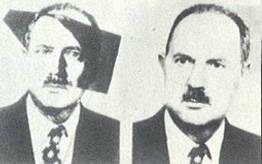 Hitler’s hairline and moustache (l) revised to highlight the resemblance to his ‘son’ (r).
Hitler’s hairline and moustache (l) revised to highlight the resemblance to his ‘son’ (r).
The Le Point story is another challenge to the traditional view of Adolf Hitler
When the much-vaunted ‘Hitler Diaries’ appeared in 1983, I was probably among thousands of history students who immediately said, “Bollocks”. Although this was billed as yet another great coup for Newscorp, Hitler was the last person on Earth to keep a diary: disorganised and at times staggeringly lazy, the Fuhrer was a great talker – in length rather than quality of content. But he lacked the application to write anything on a regular basis. Even his book Mein Kampf was dictated to faithful poodle Rudolf Hess in Landsberg prison during 1924. Hitler left everything organisational to those below him – especially his secretary Martin Bormann – and usually gave the same job to at least two people…an excellent way to keep the Party bickering internally without threatening him…while giving him much of the day to eat cake and plan buildings in post-war Berlin.
I have to confess to having been fascinated by Adolf from an early age – he was the subject of my University History thesis in the 1960s – and apart from the mad conspiracy stuff, I read the main new books that come out about him. So it may seem odd that having seen the latest piece about him fathering a son during the First World War, my reaction fairly quickly was to think the story could be true.
There are various reasons for this. The first is that a distance of 73 years has toned down the madman-with-one-ball stuff that was standard fare while I was studying for a degree in the Sixties. What fascinates me about Adolf Hitler is that he was, apart from a sort of idiot savant political genius, an extremely dull bore with little to mark him out from the crowd. Desperate Nuremburg Nazis after 1945 depicted him as a superman with irresistible will, and of course it was very important for the Allies to depict him as a jet-black evil monster. Later still, the BundesRepublik worked hard for forty years to present him as a one-off hysteric, and ensure that every last press release used the word ‘Austrian’.
It wasn’t until the German movie Der Untergang came out in 2004 that the German people were finally faced with the reality students of Hitler’s life had known for many years: he was probably not insane, he was chivalrous with women, he loved dogs, he had a sexual appetite, he was….well, an ordinary little cake-eating petit-bourgeois from Linz. This is the true and much more terrifying reality: how could a man not off his head order the things he did?
It’s hard to dispute that the German Fuhrer was a megalomaniac with an acute domination complex, but that’s not enough of a case for insanity to be diagnosed. Except right at the end, there is no evidence at all that he was delusional. The only remaining audio clip of Hitler talking to Quisling in 1943 suggests a measured man who didn’t privately see the Russians as ‘Untermenschen’ at all, and indeed admitted having underestimated them. There is a large body of circumstantial evidence to suggest that sexually, with his niece Geli Raubal, like some dominant men he got off on being humiliated with faeces. But many historians now accept the testimony of former SS and Gestapo security officers that Hitler’s bed antics with his long-term mistress Eva Braun were filmed – and betrayed nothing more than a normal healthy appetite. He did not have one testicle (both were present) but anyway a missing testicle need not mean an inability to repoduce. Otto Strasser – a Nazi who fled abroad after the 1934 SA purge – lived until 1974, and always maintained that Hitler was “sexually active” with Eva Braun.
During the 1914-18 War, Hitler served at length in France. There it is alleged that, after a brief and tipsy affair with the 16 year-old Charlotte Lobjoie, during a break from the trenches in June 1917, she gave birth to his son Jean-Marie Loret – who died aged 67 in 1985. The timelines fit very well, the mother owned paintings signed by Hitler, and only very late in life did she reveal his ‘identity’ to the son. He then lived a life close to nervous breakdown, weighed down by the knowledge of who he was. Neither mother nor son profited to any real commercial degree at all. For many years afterwards, Hitler corresponded with Lobjoie, and during the Nazi occupation of France – during which Jean-Marie was an active Resistance member – it seems to have been fairly well established that German forces helped the mother – and the Gestapo kept her under close surveillance.
All these factors make me inclined not to dismiss the story out of hand. But now having seen the pictures in Le Point of both Hitler and Jean-Marie Loret, I have to say the resemblance between the two men is startling. Given that no known DNA of Hitler survives, we will never know for sure whether the yarn is true. Jean-Marie had the same blood-group as the German leader, but that is far from conclusive. However, the tale represents, I think, another nail in the coffin of Adolf Hitler as a two-dimension quintessence of satanic evil. Depicting him like that has helped the human species run away from the fact that it produced him for far too long. We need to accept that, in every culture, there are mentally fairly normal people capable of the most bestial behaviour and appalling cruelty. Red-top newspaper depictions try to hide this from us more and more; but ironically, the behaviour of some tabloid journalists regularly provides ample evidence of it.




